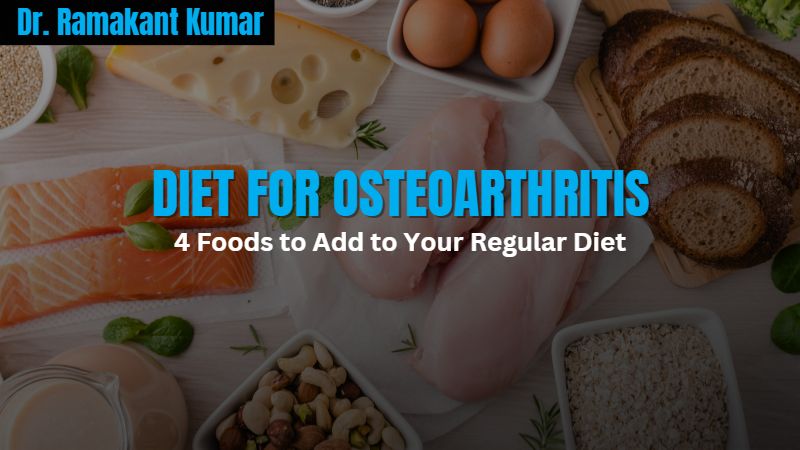Diet for Osteoarthritis (OA) is no magic that can cure the disease in a pinch of time. It helps to improve the lifestyle of patients with OA.
Osteoarthritis (OA) is a type of arthritis caused by the breakdown of the joint’s cartilage. In this joint condition, the cartilage that supports the joint wears away.
Moreover, OA is a common condition, especially among older adults. It can cause pain, stiffness, and swelling in the affected joint.
There is no specific diet that can cure osteoarthritis completely or reverse its symptoms.
But eating a healthy, balanced diet can help to manage the symptoms and slow the progression of the condition.
That said, the best Orthopedic Doctor in Patna has suggested some general dietary guidelines for people with osteoarthritis.
Contents
Diet for Osteoarthritis: What to Eat
Eating a healthy, balanced diet for osteoarthritis can help you get various nutrients that can help to manage pain, inflammation, stiffness, and more.
Moreover, the food patients eat has a vital role in making or breaking the strength of joints, which means if you eat healthy food, you can make your bones strong and avoid further damage.
Below are some food items that you should include in your diet to manage OA. With a healthy diet, you should also try some Exercises for Osteoarthritis for better results.
#1. Fresh Fruits and Vegetables
Eating plenty of fruits and vegetables is an important part of a healthy diet for people with osteoarthritis.
They are rich in various nutrients that help to support joint health and reduce inflammation, such as vitamins, minerals, antioxidants, and more.
Here are some specific fruits and vegetables that may be especially beneficial for people with osteoarthritis include:
Leafy green vegetables, such as spinach, kale, and collard greens. These vegetables are rich in vitamins C and E, which are powerful antioxidants that can help to protect the joints from damage.
Citrus fruits, such as oranges, grapefruits, and lemons. These fruits are high in vitamin C, which can help to support collagen production in the joints.
Berries, such as strawberries, raspberries, and blueberries. They’re high in antioxidants and anti-inflammatory compounds that can help to reduce joint pain and stiffness.
Cruciferous vegetables, such as broccoli, cabbage, and cauliflower. These vegetables are high in vitamin K, which is important for maintaining strong, healthy bones.
In addition to the foods listed above, other good options for people with osteoarthritis include apples, avocados, pears, sweet potatoes, and carrots.
Thus, it’s important to eat a variety of fruits and vegetables to get the most benefit. You can also try these Foods for Strong Bones and Joints.
#2. Omega-3 Fatty Acid Foods
Omega-3 fatty acids are a type of unsaturated fat that is found in certain foods and supplements. It has anti-inflammatory properties, which makes it a great choice for people with osteoarthritis.
As we know, inflammation is a major contributor to OA, so reducing it can help to manage the pain and stiffness associated with it.
Omega-3 fatty acids are a natural anti-inflammatory agent. They work by reducing the production of pro-inflammatory compounds in the body.
According to studies, omega-3 fatty acids can reduce the production of cytokines and prostaglandins that help to reduce joint pain, stiffness, and swelling.
Some foods that are high in omega-3 fatty acids include:
- Fatty fish, such as salmon, mackerel, and sardines.
- Plant-based sources of omega-3 fatty acids include flaxseeds, chia seeds, and walnuts.
- In addition, you can also get omega-3 fatty acids from supplements, such as fish oil or krill oil.
Note: It’s important to talk to your doctor before taking any supplements. Your doctor can help you determine the right dose and type of omega-3 fatty acid supplement, depending on your needs.
#3. Low-Fat Dairy Foods
Low-fat dairy foods can be a healthy and nutritious choice for people with osteoarthritis. Dairy foods are a good source of calcium and vitamin that can support joint health.
Moreover, it also provides protein that is important for building and maintaining strong, healthy bones.
However, not all dairy foods are equally beneficial for people with OA. Full-fat dairy products, such as whole milk and full-fat cheese, are high in saturated fat.
Note: Saturated fat can increase inflammation in the body, which can worsen the symptoms of osteoarthritis and may result in further damage to the joint.
On the other hand, low-fat dairy products are lower in saturated fat and can be a great diet for osteoarthritis. They are a good source of other essential nutrients, such as vitamin D and calcium.
Moreover, Vitamin D helps the body to absorb calcium, which is important for maintaining strong, healthy bones.
Below are some osteoarthritis diet examples of low-fat dairy foods that you can include in your diet:
- Milk
- Yogurt
- Low-fat cheese
- Skimmed milk.
Thus, these are some low-fat dairy products that you can include in your diet to manage the symptoms of osteoarthritis.
#4. Fortified Foods
Fortified foods are foods that have been enriched with additional vitamins, minerals, and other healthy nutrients that are essential for strong bones and joints.
These nutrients can help to build and maintain healthy bones and joints. Also, they help to reduce the symptoms of osteoarthritis.
Some examples of fortified foods that can be beneficial for people with osteoarthritis include:
Cereals and grains: They are fortified with vitamins and minerals, such as vitamin D, calcium, and magnesium. These nutrients are important for maintaining strong, healthy bones.
Dairy products: Milk and yogurt are fortified with vitamin D. Vitamin D helps the body to absorb calcium, which is essential for maintaining bone density.
Orange juice: It’s often fortified with calcium, which is important for maintaining strong, healthy bones.
Tofu: It’s a plant-based protein that is often fortified with calcium, magnesium, and other nutrients that support joint health.
Note: It’s important to remember that fortified foods are not a substitute for a healthy, balanced diet. They can be a useful way to get extra nutrients.
People with OA should use them in addition to, not instead of, fresh fruits, vegetables, and other whole foods.
Hence, these are the foods that you must add to your diet for osteoarthritis to improve the overall condition of the joint.
You should also read: Best Exercises for Building Bone Density.
Conclusion
An osteoarthritis diet helps to manage the symptoms and improve the overall condition of the joint.
In the above sections, we’ve discussed some foods that you should include in your regular diet to reduce inflammation, pain, and stiffness of the affected joint.
However, it’s important to remember that everyone is different, and what works for one person may not work for another.
If you have osteoarthritis, it’s best to work with a registered dietitian to develop a personalized meal plan that meets your individual needs and goals.
Hope you find this Osteoarthritis dietary guideline helpful and informative. If you need to ask something, you can ask in the comments or contact the best Ligament Doctor in Patna!




